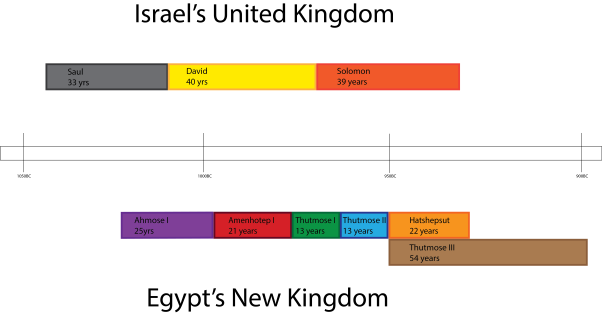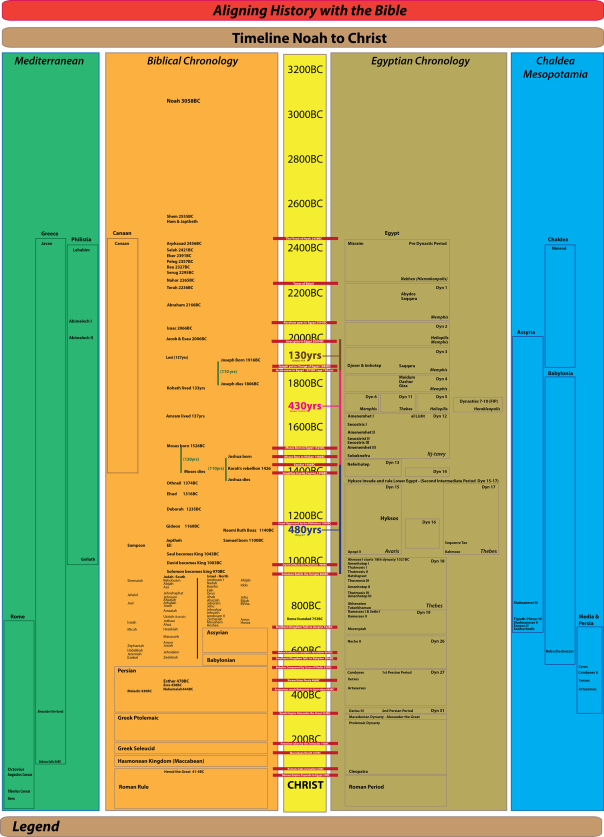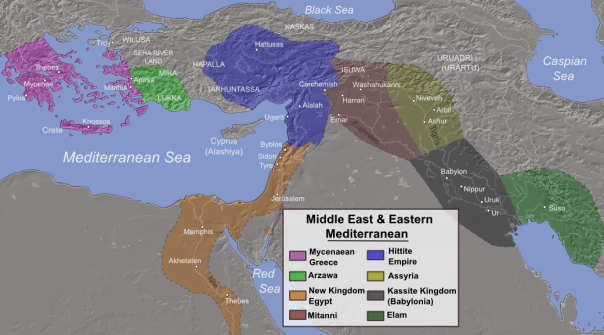Hatshepsut = Queen of Sheba, Thutmose III = Shishak and Shosheng I = So
Shishak (Hebrew: שישק, Shīʼshaḵ; Greek: Σουσακείμ, Sousakeīm), an Egyptian pharaoh mentioned in the Biblical books of 1 Kings and 2 Chronicles and a contemporary of the Israelite kings Solomon and Rehoboam. With better understanding of the ordering of the Egyptian dynasties and the revised Egyptian Chronology, it would seem that the best candidate for Shishak is now Thutmose III, the 6th Pharaoh of the 18th dynasty. He had a co-regency with Hatshepsut for 22 years as he was too young to rule when his father Thutmose II died. He ruled for another 32 years after Hatshepsut’s death. Hatshepsut was probably the Queen of Sheba who visited Solomon after he had built the temple. Thutmose III / Shishak plundered Jerusalem at the battle of Megiddo in the year following Hatshepsut’s death taking many of the treasures in Solomon’s temple including 300 gold shields, as recorded in the temple at Karnak. Traditionally, scholars and archaeologists have identified Shishak with Pharaoh Shoshenq I, although more recently historian David Rohl has claimed Rameses II as Shishak, based on a variety of circumstantial evidence. Seti I – the father of Ramses II has also been suggested. Immanuel Velikovsky identified Shoshenq I as So, the Pharaoh with whom King Hoshea of the Kingdom of Israel (“The Northern”) attempted to form an alliance. He based that on a comparison of victory stela of Thutmose III and Shoshenq I: while each of these kings records a tribute paid him by a Hebrew king, Thutmose boasts of fighting a war to get his tribute, while Shoshenq does not.

Thutmose III smiting Canaanite enemies on the seventh pylon at Karnak describing the Battle of Megiddo
Shishak / Thutmose III was a contemporary of Solomon as well as Jereboam and Rehoboam.
While Solomon was alive, in the latter part of his reign, Jereboam fled from Solomon and took refuge with Shishak, Pharaoh of Egypt. After Solomon’s death, Jereboam returned to Caanan where he was made King over the ten northern tribes of Israel. Jereboam and Rehoboam were constantly at war thoughout their reign. Shishak / Thutmose III plundered Jerusalem in Rehoboam’s 5th year as king at the Battle of Megiddo shortly after Hatshepsut’s death.
Thutmose III = Shishak
Thutmose III
Thutmose III is considered to be one of the Greatest Pharaohs of Egypt expanding the the Egyptian Empire further than any other Pharaoh. He conducted 17 campaigns, conquering as far north as Niya in Syria and as far south as the 4th cataract of the Nile in Nubia.
Thutmose III attacked Caanan in his 23rd year (The Seige of Megiddo) after Hatshepsut’s death. He plundered Jerusalem in the 5th year of King Rehoboam and took many of the treasures in Solomons temple back to Egypt. He was the Pharaoh named Shishak recorded in the Bible. The seige of Megiddo lasted 7-8 months, after which Thutmose III gained control of Northern Caanan. Thutmose III recorded his victories at Karnak.
The Syrian princes were obliged to pay tribute and their sons were taken as hostages to Egypt.
His mummy was discovered in the Deir el-Bahri cache above the mortuary temple of Hatshepsut. The mummies of Ahmose I, Amenhotep I,Thutmose I, Thutmose II, Rameses I, Seti I, Rameses II, Rameses IX were also found in the cache as well as some mummies of the 21st dynasty.
Thutmose III ruled for a period of 54 years, the first 22 years being co-regent with Hatshepsut (the queen of Sheeba who visited Solomon). His first born son Amenemhat predeceased Thutmose III. He had a 2 year co-regency with Amenhotep II at the end of his reign. Amenhotep II (the 7th pharaoh of the 18th dynasty) was the son of Hatsehpsut. Thutmose III was buried in the valley of the Kings when he died.
Biblical Account
Shishak first appears in the Biblical narrative as a patron of Jeroboam, one of Solomon’s sons who fled from the presence of his father:
“Solomon sought therefore to kill Jeroboam. But Jeroboam arose and fled into Egypt, to Shishak king of Egypt, and was in Egypt until the death of Solomon.” – 1_Kings 11:40
His second appearance would be in a raid against King Rehoboam of the Southern Kingdom of Judah:
“In the fifth year of King Rehoboam, because they had been unfaithful to the LORD, Shishak king of Egypt came up against Jerusalem with 1,200 chariots and 60,000 horsemen. And the people were without number who came with him from Egypt—Libyans, Sukkiim, and Ethiopians. And he took the fortified cities of Judah and came as far as Jerusalem. Then Shemaiah the prophet came to Rehoboam and to the princes of Judah, who had gathered at Jerusalem because of Shishak, and said to them, “Thus says the LORD, ‘You abandoned me, so I have abandoned you to the hand of Shishak.'” Then the princes of Israel and the king humbled themselves and said, “The LORD is righteous.” When the LORD saw that they humbled themselves, the word of the LORD came to Shemaiah: “They have humbled themselves. I will not destroy them, but I will grant them some deliverance, and my wrath shall not be poured out on Jerusalem by the hand of Shishak. Nevertheless, they shall be servants to him, that they may know my service and the service of the kingdoms of the countries. So Shishak king of Egypt came up against Jerusalem. He took away the treasures of the house of the LORD and the treasures of the king’s house. He took away everything. He also took away the shields of gold that Solomon had made.” – 2_Chronicles 12:2-9
The relationship between the Egyptian Kingdoms and dynasties and the various phases of Israel

A schematic diagram illustrating the relationship between the Egyptian Kingdoms and dynasties and the various phases of Israel as the Israelites grew to be a nation while they were in Egypt and then traveled to the promised land where they were ruled initially by Judges and later by Kings. The nation of Israel became divided into North (Israel) and South (Judah) after Solomon. There was no first intermediate period.
Theories based on sequential Egptian dynasties (the traditional long chronology which is now thought unlikely)
The further back in time, the greater the error
Archaeological evidence and Historical Correlates of the Bible in the time of the Kings of Israel
•The Black Obelisk of Shalmaneser III (858-824 B.C.) shows Jehu, king of Israel, bowing before the Assyrian king. This is the only known picture of an Israelite king.
•Tablets from the time of Tiglath-Pileser (744-727 B.C.) state that he received tribute from Jehoahaz of Judah. This is the full name of Ahaz (2 Kings 16:7).
•A wonderfully detailed limestone relief from Sennacherib’s palace at Nineveh shows the siege of Lachish.
•One of the most important is the cylinder of Nabonidus (555-539 B.C.). He was the last ruler of the Neo-Babylonian Empire. This stele proves that his son Belshazzar was co-regent with him (Daniel 5; 7:1; 8:1). Scholars previously scoffed at Belshazzar’s existence.








